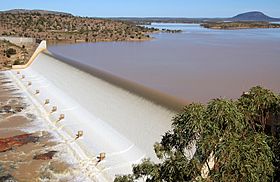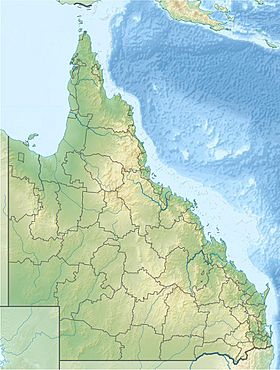Burdekin Dam facts for kids
Quick facts for kids Burdekin Dam |
|
|---|---|

Burdekin Dam, 2009
|
|
|
Location of the Burdekin Dam wall in Queensland
|
|
| Official name | Burdekin Falls Dam |
| Country | Australia |
| Location | North Queensland |
| Coordinates | 20°38′33″S 147°08′27″E / 20.64250°S 147.14083°E |
| Purpose | Irrigation |
| Opening date | 1987 |
| Owner(s) | SunWater |
| Dam and spillways | |
| Type of dam | Gravity dam |
| Impounds | Burdekin River |
| Height | 55 m (180 ft) |
| Length | 876 m (2,874 ft) |
| Dam volume | 1,860,000×103 m3 (66,000×106 cu ft) |
| Spillways | 1 |
| Spillway type | Uncontrolled |
| Spillway capacity | 64,600 m3/s (2,280,000 cu ft/s) |
| Reservoir | |
| Creates | Lake Dalrymple |
| Total capacity | 1,860,000 ML (410×109 imp gal; 490×109 US gal) |
| Catchment area | 114,220 km2 (44,100 sq mi) |
| Surface area | 22,400 ha (55,000 acres) |
| Maximum water depth | 40 m (130 ft) |
| Normal elevation | 154 m (505 ft) |
The Burdekin Dam, also known as the Burdekin Falls Dam, is a huge concrete dam in Queensland, Australia. It was built across the Burdekin River to help with irrigation, which means providing water for farms. The big lake behind the dam is called Lake Dalrymple. SunWater looks after the dam. The water from Lake Dalrymple also helps refill underground water sources called aquifers.
Contents
About the Dam
The Burdekin Dam is a gravity dam. This means it uses its own weight to hold back the water. It has a special part called an uncontrolled spillway. This lets extra water flow out when the dam is full.
Dam Size and Lake Dalrymple
The dam wall is about 876 meters (2,874 feet) long. It has a spillway that is 504 meters (1,654 feet) wide. Water can drop about 37 meters (121 feet) over the spillway.
The lake behind the dam, Lake Dalrymple, is very big. It can hold 1,860,000 megalitres of water. To give you an idea, that's four times the amount of water in Sydney Harbour! The lake covers an area of about 22,400 hectares (55,000 acres). At its deepest, the lake is about 40 meters (131 feet) deep.
Water Catchment Area
The water that fills Lake Dalrymple comes from a huge area. This area is called the catchment area. It stretches far north, south, and west of the dam. Rivers like the Suttor River and Belyando River flow into it.
Dam History
Building the Burdekin Dam started in 1984. It was finished by Leighton Contractors in 1987. It is the largest dam in Queensland. The dam filled up for the first time after the wet season in 1988.
Water for Farms
The Burdekin Dam is very important for farming. The Burdekin River Irrigation Area was approved in 1980. It is Queensland's biggest plan for land and water conservation. In 2007, this plan provided water to over 103,000 hectares (250,000 acres) of land. This land is about 200 kilometers (120 miles) inland from Townsville. Farmers use this water to grow many crops. These crops include sugar cane, cotton, and rice.
Future Power Plans
There are plans to build a hydroelectric power station below the dam. This power station would use the force of the water to make electricity. It could produce enough power for more than 9,500 homes every year. Stanwell Corporation is studying if this project is possible.
Boating on Lake Dalrymple
You can go boating on Lake Dalrymple. There is a boat ramp near the dam wall. However, the water can sometimes be muddy. This happens when rains wash dirt into the lake. Muddy water can make fishing harder. It also means you need to be careful when boating fast. There might be hidden rocks under the water.
Animals in the Dam
Lake Dalrymple is home to many fish. Some fish have been put into the dam on purpose. These include sleepy cod, sooty grunter, and barramundi. Many other types of fish live there naturally. These include forktail catfish, spangled perch, eel-tailed catfish, long tom, golden perch, and archer fish.
If you want to fish in the dam, you need a special permit. You might also find red-claw crayfish and freshwater crocodiles in the dam. These crocodiles are not originally from this river. They were likely released by people who caught them from other rivers. Saltwater crocodiles are also known to visit the dam's reaches.
Awards
In 2009, the Burdekin Falls Dam received an award. It was named one of the Q150 Icons of Queensland. This award was given for its important role as a great "structure and engineering feat."



